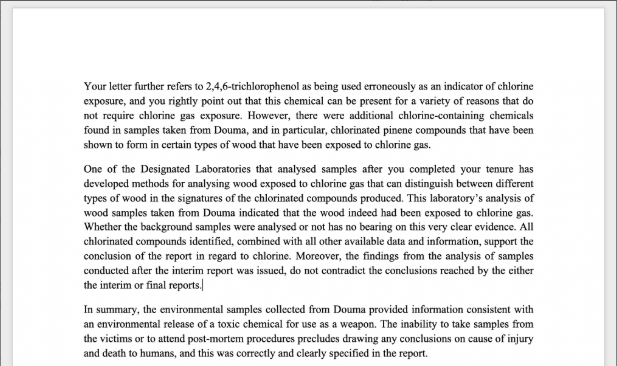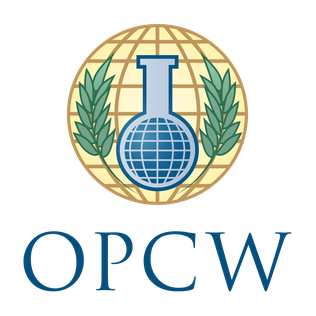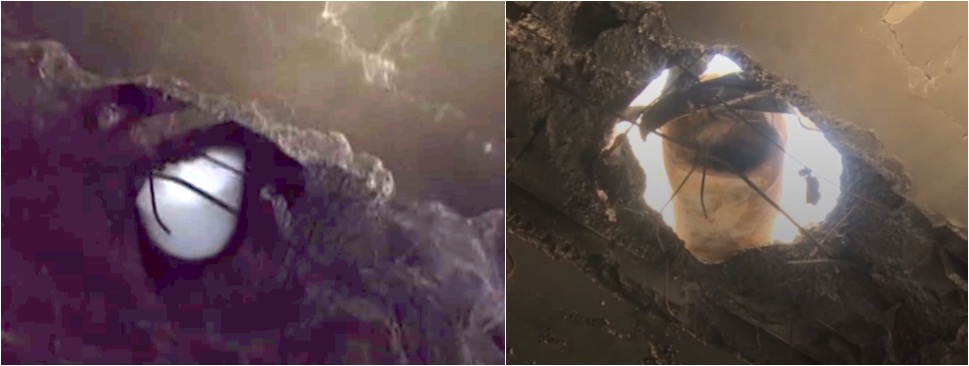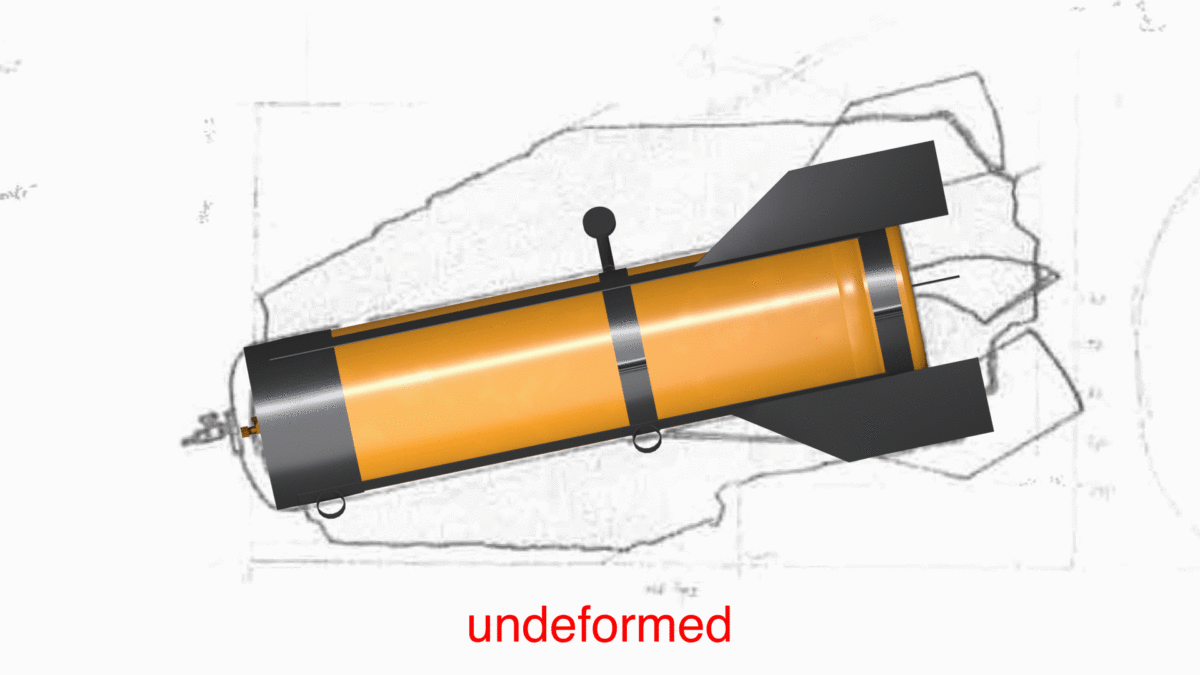Unpublished OPCW Douma Correspondence Casts Further Doubt on Claims of 'Doctored' Report
Editorial note: Since this article was published, it has been reported that the final version of the letter received by Whelan differed significantly from the draft version seen by Bellingcat. The final version omits much of the information contained within the draft version. Bellingcat stands by the extra information in the draft version and has verified its authenticity and its conclusions — that the OPCW’s finding that a chemical attack did occur was based on analysis carried out after Whelan left the organisation. Moreover, chemical evidence available at the time of his presence in the organisation was sufficient to come to this conclusion. Further, the final version of the letter released by The Greyzone supports this conclusion.
Last year, a whistleblower codenamed ‘Alex’ teamed up with Wikileaks to expose what appeared to be a major scandal with global implications – the Organisation for the Prohibition of Chemical Weapons (OPCW), had “doctored” a report in order to a fabricate chlorine attack in Syria when no such event had actually occurred.
This was done, insinuated ‘Alex’, in order to frame the Syrian government and justify the missile strikes launched by the US, UK and France against forces loyal to the government of Bashar al-Assad in the days following the attack on the town of Douma in April 2018.
WikiLeaks also released several batches of internal OPCW documents ostensibly supporting the claims made by ‘Alex’. Russian state media seized upon these leaks. They would ultimately be presented by Assad’s Russian allies at the United Nations in January, where it was claimed the chemical attack was staged and the Organisation for the Prohibition of Chemical Weapons (OPCW) had been hijacked by Western nations and was no longer fit for purpose.
The story was eagerly picked up by a number of British and American journalists including Peter Hitchens at the Mail on Sunday, Robert Fisk at The Independent and Aaron Mate at The Grayzone.
While the leaked documents were authentic, Bellingcat’s previous investigations have shown that the claims which these journalists made which cited them as supporting evidence were either overblown or misleading. They also omitted some key pieces of information.
A draft version of a letter seen by Bellingcat and not publicly released by either ‘Alex’, Wikileaks or any of the journalists who have covered the so-called scandal, proves that a chemical attack did occur. It shows that any notion of a cover-up at the OPCW is false and confirms that the organisation acted exactly as it was mandated to.
Further, it also reveals that at a diplomatic level behind closed doors, the Russian and Syrian governments have both agreed with the conclusions of the OPCW report. Yet in public – and with the help of a number of Western journalists and academics – Russia has launched a widespread and concerted effort to undermine both the OPCW and the conclusions of its report on Douma.
The Leaks
The source of the leaks is a whistleblower codenamed ‘Alex’ – former OPCW employee, Brendan Whelan. He had been part of the team that investigated the chemical attack in the Syrian town of Douma on April 7, 2018 in which at least 41 civilians were killed.
Whelan was part of a Fact-Finding Mission (FFM) that visited the site of the attack to gather evidence on the ground. Whelan then left the OPCW in August 2018, shortly after this work was conducted and before the majority of the analysis was carried out.
This evidence was then handed to other departments in the OPCW for scientific and technical analysis. As per the rules of its mandate in the Syrian civil war, the OPCW then determined if chemical weapons had been used in contravention of international law.
In March of last year, the OPCW released a report concluding that chlorine had indeed been used as a weapon in the attack.
Although not mandated to assign blame, the report’s conclusions that the chlorine came from two cylinders dropped from the air, tacitly attributing responsibility to the Syrian government as it is the only side in the conflict that has an air force.
Such a conclusion came as no surprise following the nearly decade-long conflict, as the Syrian government of Bashar al-Assad has a well-documented history of using chemical weapons against civilians.
In the immediate aftermath of the attack Russia, which intervened in Syria in 2015 in support of president Bashar al-Assad’s violent crushing of a popular revolution, sought to deflect blame from its ally.
It mobilised both Russian government officials and Russian state media to sow doubt about what had actually happened, throwing out a multitude of unfounded theories from “no attack happened at all” to “British spies did it” to “the White Helmets did it”.
The Russian disinformation campaign received what appeared to be a major boost with the leaking of documents from the OPCW last year.
The leaks make clear that Whelan and another member of OPCW that investigated the Douma attack, Ian Henderson, had concluded that chlorine gas had not been used as a weapon and the attack had in fact been staged.
The majority of the leaked documents are correspondence between Whelan and other members of the OPCW in which he expresses outrage that his initial findings were overruled in the final report.
In October 2019, Whelan presented his evidence to a panel convened by the Courage Foundation, a trust founded by Wikileaks to aid whistleblowers.
Among those on the panel was WikiLeaks editor Kristinn Hrafnsson, who said afterwards: “The panel was presented with evidence that casts doubt on the integrity of the OPCW.”
The Letter
What Wikileaks did not release was a letter drafted by several members of the OPCW in June 2019 and then sent by the director general of the organisation, Fernando Arias, in reply to a letter from Whelan.
In Whelan’s letter he claimed there was no evidence of chlorine being used as a weapon in Douma, and traces of chlorine that were found were not consistent with the release of chlorine gas.
In a draft version of the unpublished reply seen by Bellingcat, Arias explains why Whelan’s assumptions are wrong – he simply wasn’t aware of the latest scientific techniques used by the OPCW because they were developed after he left the organisation. It was these techniques that allowed the OPCW to conclude chlorine chlorine gas had been released in the building in which the Syrian civilians died.
In his letter, which was drafted with the input of several OPCW scientists, Arias wrote: “Your letter further refers to 2,4,6-trichlorophenol as being used erroneously as an indicator of chlorine exposure, and you rightly point out that this chemical can be present for a variety of reasons that do not require chlorine gas exposure. However, there were additional chlorine-containing chemicals found in samples taken from Douma, and in particular, chlorinated pinene compounds that have been shown to form in certain types of wood that have been exposed to chlorine gas.

Screenshot of the draft letter. Photo from Bellingcat Investigation Team.
“One of the Designated Laboratories that analysed samples after you completed your tenure has developed methods or analysing wood exposed to chlorine gas that can distinguish between different types of wood in the signatures of chlorinated compounds produced. This laboratory’s analysis of wood samples taken from Douma indicated that the wood indeed had been exposed to chlorine gas. Whether background samples were analysed or not has no bearing on this very clear evidence. All chlorinated compounds identified, combined with all other available data and information, support the conclusion of the report in regard to chlorine. Moreover, the findings from the analysis of samples conducted after the interim report was issued, do not contradict conclusions reached by either the interim or final reports.
“In summary, the environmental samples collected from Douma provided information consistent with an environmental release of a toxic chemical for use as a weapon. The inability to take samples from the victims or attend post-mortem procedures precludes drawing any conclusions on cause of injury and death to humans, and this was correctly and clearly specified in the report.”
In short, the OPCW report did exactly as mandated and established that a chemical weapon was used.
It did not specify how the victims died as this was not part of its mandate. A separate OPCW investigation has been mandated to examine this as well as assign blame for the attack.
The Journalists
As mentioned above, a number of journalists have seized upon the documents released by ‘Alex’ as evidence that the OPCW falsified its report on Douma in order to frame the Syrian government for the attack and justify missile strikes launched by the US, UK and France against the government of Bashar al-Assad.
Peter Hitchens at the Mail on Sunday, and Aaron Mate at The Grayzone have both written extensively on the matter, relying heavily on the documents released by Wikileaks to reach their conclusions.
It is not known if Wikileaks, Hitchens, or Mate are aware of or have seen the document seen by Bellingcat which contradicts their work.
Prior to the publication of this article, the only public acknowledgment of the existence of the letter from Arias to ‘Alex’ is in an article by Hitchens in which ‘Alex’ himself mentions it (point 51 here)
When given the opportunity to comment for this article, Wikileaks and Hitchens failed to respond.
Mate wrote in an email: “As a general rule, I do not comment on information that I may have or have not received, but have never written about. I have never written about the document you refer to.”
Three members of the Courage Foundation who were at the presentation by ‘Alex’ – Jose Bustani, Helmut Lohre and Gunter Meyer – were also asked about the document. None responded.
As well as pen articles on the supposed OPCW scandal, Mate went one step further and last month testified at the United Nations at the invitation of the Russian government where he accused the OPCW of falsifying its report on Douma.
He made no mention of the evidence outlined in the letter from Arias to ‘Alex’.
There is another passage in the letter which further casts the UN event at which Mate spoke as a public relations charade designed by the Russians as a disinformation exercise.
Arias wrote: “I would further like to point out that the conclusion of the final Douma report is not in question. No State Party has questioned the conclusion that there are reasonable grounds to believe that a toxic chemical was used as a weapon in Douma.
“This includes the Syrian Arab Republic and the Russian Federation, which in recent weeks have each sent us comments and questions on the final Douma report in notes verbale in which they themselves have indicated their agreement with the conclusion of the final report. These notes verbale, as well as our replies to them, have been made available to State Parties.”
Update: When asked by Bellingcat’s Eliot Higgins after the publication of this article as to whether he had received a copy of the aforementioned document, Mate stated on Twitter that he had not, nor had he been aware of its existence.
Further update: Upon further consideration of Whelan’s earlier statements, we have corrected the word “alleged” to “insinuated”.


